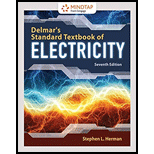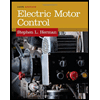
EBK MINDTAP FOR HERMAN'S DELMAR'S STAND
7th Edition
ISBN: 9781337900614
Author: Herman
Publisher: VST
expand_more
expand_more
format_list_bulleted
Concept explainers
Question
Chapter 33, Problem 27RQ
To determine
Why do stepping motors have teeth machined in the stator poles and rotor.
Expert Solution & Answer
Want to see the full answer?
Check out a sample textbook solution
Students have asked these similar questions
Don't use ai to answer I will report you answer
Don't use ai to answer I will report you answer
Answer all the questions
What is the minimum value of capacitor C1 required such that Vfiltered does not drop below 8 V? Use the design equation(but make sure you use the right “frequency” and the correct ripple voltage). Show your calculations. Display your circuit in circuit js.
Display Vsecondary (can use the voltage across the added 100 kΩ resistor) and Vfiltered in a “Combined Scope”. Display VDC in a separate scope: a) Turn on “Max Scale”, “Show Peak Value” and “Show Negative Peak Value”: b) Run the simulator and adjust the window and simulation speed and time step to be able to see a couple of cycles. Include a screen capture
Document the minimum and maximum values for Vfiltered in your lab report. Is Vfiltered maintained to be above 8 V? By how much? Why? Explain the waveform shape captured Vfiltered. It may help your understanding to rerun the simulation with C1 removed and compare that waveform for Vfiltered to that captured
Chapter 33 Solutions
EBK MINDTAP FOR HERMAN'S DELMAR'S STAND
Ch. 33 - What are the three basic types of split-phase...Ch. 33 - The voltages of a two-phase system are how many...Ch. 33 - How are the start and run windings of a...Ch. 33 - In order to produce maximum starting torque in a...Ch. 33 - What is the advantage of the capacitor-start...Ch. 33 - On average, how many degrees out of phase with...Ch. 33 - What device is used to disconnect the start...Ch. 33 - Why does a split-phase motor continue to operate...Ch. 33 - How can the direction of rotation of a split-phase...Ch. 33 - If a dual-voltage split-phase motor is to be...
Ch. 33 - When determining the direction of rotation for a...Ch. 33 - What type of split-phase motor does not generally...Ch. 33 - What type of single-phase motor develops the...Ch. 33 - Prob. 14RQCh. 33 - Prob. 15RQCh. 33 - When a repulsion-start induction-run motor reaches...Ch. 33 - Prob. 17RQCh. 33 - What causes the magnetic field to rotate in a...Ch. 33 - How can the direction of rotation of a shaded-pole...Ch. 33 - Prob. 20RQCh. 33 - Prob. 21RQCh. 33 - Prob. 22RQCh. 33 - Prob. 23RQCh. 33 - Prob. 24RQCh. 33 - What is the principle of operation of a stepping...Ch. 33 - What does the term bifilar mean?Ch. 33 - Prob. 27RQCh. 33 - When a stepping motor is connected to AC power,...Ch. 33 - What is the synchronous speed of an eight-pole...Ch. 33 - How can the holding torque of a stepping motor be...Ch. 33 - Why is the AC series motor often referred to as a...Ch. 33 - Prob. 32RQCh. 33 - How is the direction of rotation of the universal...Ch. 33 - Prob. 34RQCh. 33 - Prob. 35RQCh. 33 - Prob. 36RQCh. 33 - Prob. 1PA
Knowledge Booster
Learn more about
Need a deep-dive on the concept behind this application? Look no further. Learn more about this topic, electrical-engineering and related others by exploring similar questions and additional content below.Similar questions
- A Three-phase, 3.3 kV, Y connected, 500 kVA, 16 salient pole rotor alternator. The direct and quadrature axis synchronous reactance are 8 and 50/ph respectively. The machine is supplying a load of 350 kVA at 0.8 power factor lagging, Determine: 1. Power angle. 2. Percentage Voltage regulation. 3. Developed power. 4. Reluctance powerarrow_forwardA Three-phase, 12 pole, Y-connected alternator has 108 slots and 14 conductors per slot. The windings are (5/6th) pitched. The flux per pole is 57 mWb distributed sinusoidally over the pole. If the machine runs at 500 r.p.m., determine the following: (a) The frequency of the generated e.m.f., (b) The distribution factor, (c) The pitch factor, and (d) The phase and line values of the generated e.m.f.?arrow_forwardMany machines, such as lathes, milling machines, and grinders, are equipped with tracers to reproduce the contours of templates. The figure is a schematic diagram of a hydraulic tracer in which the tool duplicates the shape of the template on the workpiece. a) Explain how the system works. b) Draw a block diagram and identify the system's elements. c) Classify the control system. Oil under pressure Template Style Tool Piece of workarrow_forward
- 2. Refrigerators to maintain the product at a given temperature have a control system. a) Explain how the control system is or how you think it should be (Make a diagram). b) Make the typical block diagram of a control system and identify the components in the refrigerator system. c) Classify the control system.arrow_forward3. Internal combustion engines require a cooling system to function properly, which maintains the engine temperature at an appropriate value. Neither too high nor too low. There are several systems to control this temperature, the two best known are: • The classic one that uses a thermostat that regulates the flow of coolant (water), and where the fan is mechanically coupled to the engine. • In more recent vehicles, in addition to the thermostat, a temperature controller is used that turns an electric fan on and off. Select one of the two systems mentioned above and: a) Explain how it works, using diagrams. b) Make the typical block diagram of a feedback control system, identifying the components of the system. c) Classify the control system.arrow_forwardA 3-phase, star connected, 10 kVA, 380 V, salient pole alternator with direct and quadrature axis reactances of 15 and 8 0/ph respectively, delivers full-load current at 0.8 power factor lagging. Neglect the armature resistance. Determine the following: (a) The load angle, (b) The direct axis and quadrature axis components of armature current, (c) E.M.F induced voltage of the alternator, (d) The voltage regulation, and (e) The developed power by the alternator?arrow_forward
- A 2000 kVA,Y- connected alternator gives an open circuit line voltage of 3.3 kV for a field current of 65 A. For same field current the short circuit current is being equal to full load current. Calculate the full load voltage regulation at both 0.8 lagging p.f. and unity p.f., neglect armature resistance?arrow_forwardDon't use ai to answer I will report you answerarrow_forwardDon't use ai to answer I will report you answerarrow_forward
arrow_back_ios
SEE MORE QUESTIONS
arrow_forward_ios
Recommended textbooks for you
 Delmar's Standard Textbook Of ElectricityElectrical EngineeringISBN:9781337900348Author:Stephen L. HermanPublisher:Cengage Learning
Delmar's Standard Textbook Of ElectricityElectrical EngineeringISBN:9781337900348Author:Stephen L. HermanPublisher:Cengage Learning

Delmar's Standard Textbook Of Electricity
Electrical Engineering
ISBN:9781337900348
Author:Stephen L. Herman
Publisher:Cengage Learning
